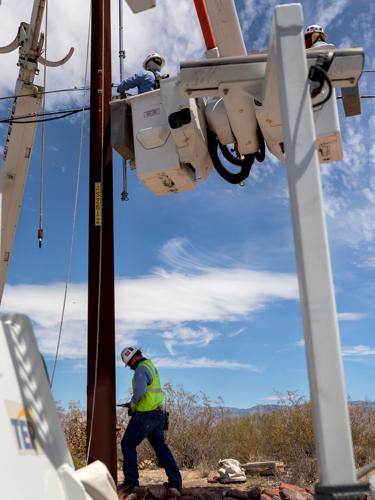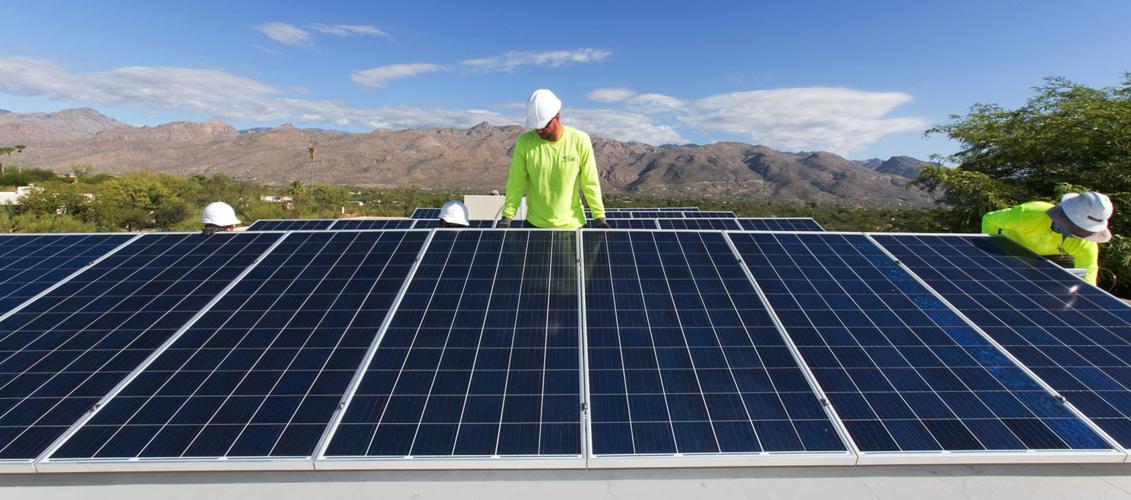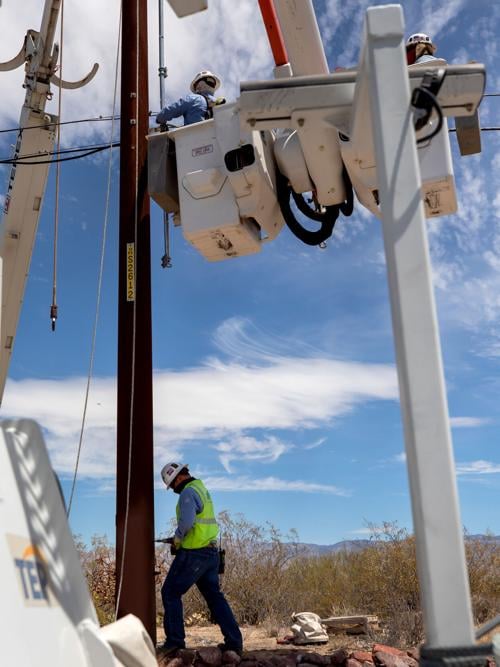Tucson will embark on a major study of whether it makes sense to boost renewable energy use by forming a city-run electric utility or by starting a program allowing the city to buy and sell solar and wind energy to residents.
Those are the highest-profile options to be looked at once the city hires a consultant to conduct the study starting this summer.
“I’d envision it will look at various ways we can decarbonize our energy source,” to reduce the use of fossil fuels to generate electricity, said Deputy City Manager Tim Thomure.
But creating a public utility would require the city to buy all the power lines, poles and other infrastructure Tucson Electric Power uses to deliver electricity to homes and businesses here — at a very high price.
“It makes no sense for the city to form a public power utility,” said Shelly Gordon, president of Arizonans for Community Choice, which supports the formation of programs that let the city buy energy supplies of its choosing. “They can do the same thing for less money with community choice (programs).”
Thomure described forming a municipal electric utility as a “very heavy lift,” but added, “so is fighting climate change a very heavy lift.”
“Financially it would be expensive. Would there be value from doing that lift? Is that the best investment for anybody’s resources? It is a big community question,” Thomure said.
“If we’re going to do a comprehensive energy sources study, it is imperative to look at all potentially viable options, to provide the mayor and council with the best information to make a decision,” he said.
Under community choice or community aggregation programs, as they are known in various states, the city could buy energy from sources of its choosing to deliver to customers. Its backers say it would bring competition to what they now regard as a monopoly utility that controls Tucson’s energy sources.
“Under the current structure of monopoly utilities, customers have no other option. This model has been around 150 years. We are trying to change that,” Gordon said.
Advocates say community choice would put a lid on electric rates and bills, if not lower them. Unlike a private utility, a community choice program doesn’t have to earn profits to satisfy shareholders. While such programs exist in 10 other states including California, they’re not allowed here, meaning the Legislature or the Arizona Corporation Commission would have to legalize them.
“Giving customers and citizens a voice and a choice in their utility services is important,” Thomure said. “On the surface, I think it’s a great thing to pursue. We don’t yet know the practicalities of it.”
TEP: Electric bills would go up
Both public utility and community choice options draw skepticism from Tucson Electric Power officials, and, in the case of a public utility, outright opposition.
The cost of buying TEP’s system would overwhelm the city’s finances, limiting Tucson’s ability to deliver other services, while also restricting other investments in reliable service and clean energy, TEP spokesman Joe Barrios said.
Utility officials are also concerned their customers who didn’t join a community choice program would be stuck with higher electric bills because the utility would then have to spread its expenses over a smaller customer base. Advocates on the other side, though, say the problem could be eased by paying private utilities “exit fees” to compensate for financial losses utilities suffer from losing customers to community choice programs.
Barrios, however, said utility officials anticipate that setting fees high enough to maintain service reliability for program participants would mean community choice participants likely would pay higher electricity rates than other customers, “as TEP can contract for renewable energy at costs lower than community choice programs due to economies of scale.”
Disagreeing is Russell Lowes, a longtime, Tucson-based solar energy advocate. He said he’s done computer modeling that showed exit fees set at the rate he’s typically seen nationwide would make electricity rates 22% lower than TEP’s. Double the fee, and ratepayers would still save 10%, he said.
TEP has committed “to working in good faith with City of Tucson staff toward an energy supply agreement that would provide up to 100 percent clean energy for city operations,” TEP President and CEO Susan Gray wrote in January to Tucson Mayor Regina Romero. “Such an agreement would signify the city’s commitment to combat climate change and serve as a significant landmark in our journey toward a cleaner energy supply for our entire community.”
While city government operations consume a very small percentage of Tucson’s electricity, TEP agreed in its 2020 resource plan to stop using coal burning for electricity by 2032 and to get 70% of its supply from renewables by 2035. It’s now working on an update to this plan to meet a state requirement.
In 2022, TEP got about 61% of its energy from the fossil fuels of coal and natural gas, compared to almost 20% from utility-generated wind and solar power. Adding solar energy produced on the rooftops of homes and businesses brings the total renewable supply to 26.5% of total Tucson-area energy use, with other sources comprising the balance.

In 2022, TEP got about 61% of its energy from the fossil fuels of coal and natural gas, compared to almost 20% from utility-generated wind and solar power. Adding solar energy produced on the rooftops of homes and businesses brings the total renewable supply to 26.5% of total Tucson-area energy use, with other sources comprising the balance.
Three energy economics experts interviewed by the Arizona Daily Star described TEP’s 2035 goal of 70% renewables as ambitious or very ambitious. One, Loyola University of Chicago professor Gilbert Michaud, noted the most aggressive renewable energy goals pushed by utilities nationwide typically reach their maximum renewable percentage, sometimes up to 100%, by dates such as 2050.
“It’s a commendable goal. It’s also incredibly aggressive. I have concerns as to whether it’s achievable,” said Michaud, an assistant environmental policy professor, of TEP’s 70% goal.
Many environmentalists in Tucson, across Arizona and elsewhere, however, say the 70% renewables goal by 2035 isn’t ambitious enough. The International Panel on Climate Change has said the world needs to reduce greenhouse gas emissions 43% by 2030 and reach “net zero” emissions by 2050. Limiting global warming will involve “substantial reductions in fossil fuel use, widespread electrification, improved energy efficiency and use of alternative fuels,” the IPCC said last year, without offering specific targets.
The new study is among the first steps Tucson is taking to try to carry out its Climate Action Plan, which the City Council adopted last month. The plan’s goal is to make the city “carbon neutral” by 2045 and have all city facilities achieve that status by 2030. Carbon neutrality would mean no more heat-trapping carbon dioxide gases would be released into the air here than are captured by trees and other means within the city.
The study, whose cost isn’t yet known, is being launched due to input from residents “about the importance of having reforms in our energy sourcing to drive climate action,” Thomure said. “It’s to give community members options.”
The study will also examine the merits of individual power purchase agreements, in which the city would buy power from other sources besides TEP to serve its government operations.
It will also investigate the potential for microgrids, in which the city would provide smaller scale alternative energy supplies, “to anything from a building to a few blocks — it could be a neighborhood or an HOA (Home Owners Association),” Thomure said.
Voters’ making a choice
The study’s launch comes as Tucson voters prepare to vote by May 16 on Proposition 412, which would extend for 25 years TEP’s franchise with Tucson to operate infrastructure within city limits after its current franchise expires in 2026. If the proposition passes, TEP customers will pay an additional fee amounting to a dollar or two extra a month on their water bills.
About 90% of the $5 million raised annually by the fee would be used to build future power lines underground, while the rest of the fee would raise about $500,000 annually to pay for various climate change mitigation programs.
While TEP and most City Council members say Proposition 412’s approval would support TEP service reliability and energy “resilience,” opponents say the amount of money that would be allocated to climate mitigation is grossly inadequate. They hope a defeat of the franchise extension would prod TEP to the table to negotiate more money for climate action.
The Tucson climate action plan had recommended the study be done before the city decided whether to extend its franchise agreement. But now, regardless of how the vote turns out, the city can still move toward either a utility formation or a community choice plan if the study finds them feasible, Thomure said.
‘Definitely an uphill battle’
Nationally, “a few thousand” public power utilities exist in the United States, operating in every state but Hawaii, said Ursula Schryver, a vice president of the American Public Power Association.
While Los Angeles, Seattle and San Antonio have public power utilities, “the vast majority” operate in smaller communities, said Schryver.
About 80% serve communities of no more than 10,000 people, while 60% serve communities no larger than 5,000 people. TEP served more than 433,000 customers here as of 2021.
Schryver’s group is an advocacy organization claiming to represent public power before the federal government “to protect the interests of the more than 49 million people that public power utilities serve, and the 96,000 people they employ.”
Creating a public power utility “is definitely an uphill battle. The investor-owned utility will likely fight it,” she said.
But new such utilities continue to be created — 18 in the past 20 years, she said. Today, a number of cities are looking at it and the association is contacted annually by dozens of organizations wanting to set up such a utility.
One reason is that a number of high-profile cases of municipalization efforts, most notably in Boulder, Colorado and in the state of Maine, have encouraged other cities to examine such a scheme, she said.
“Today, a lot of the interest is currently driven by a desire to have more renewable energy, more environmentally friendly options for the community. However, there are all different reasons. Sometimes it’s rates. Sometimes it’s reliability. Economic development is another reason. It’s about having the ability to make decisions important to the community and being able to implement programs the community wants.
“The core of public power is local control,” Schryver said.
While forming a public utility is definitely feasible, “You have to be committed to working through the process. Some public power utilities are formed in three to five years. Typically, it’s 10 years. Sometimes it’s longer,” Schryver said.
Boulder also is the example that community choice activists cite as a pitfall of public power efforts. Voters in that liberal, environmentalist city decided in November 2020 to abandon municipalization efforts after 10 years. The original effort was born of frustration at what many residents say was the slow pace toward renewables of Xcel Energy, their local supplier.
Heavy opposition by Xcel kept the struggle in court for years. Concern about costs was another factor. The city was starting to run out of the $29 million that local taxpayers provided for the fight, and the COVID-19 pandemic at the time made the budget situation shakier, Colorado Public Radio reported in 2020.
“There was a realization that going to the voters asking for more money on an endeavor that really wasn’t making a whole lot of progress was probably not in the cards,” Bob Yates, Boulder’s mayor pro tem at the time, told the radio network.
But as part of abandoning municipalization, Boulder signed an agreement with Xcel to speed its emission reduction pace and saying the city could walk away from the agreement if the company didn’t meet its terms.
If Tucson wants to consider public power, it needs to analyze it and decide if it’s right for the city, Schryver said. While it may not be the right answer, just going through the process will likely prod the private utility into making more concessions — “that may be enough to get the community what it needs in the long run,” she said.
TEP’s Barrios said the company can help Tucson achieve its clean energy goals sooner and more cheaply than would a municipal utility.
“We’re already building a cleaner, greener grid at an ambitious pace that could not be matched by a resource constrained public utility,” Barrios said.
Massachusetts program lauded
Community choice advocates say some states with such programs are showing rapid progress in increasing renewable energy use while simultaneously holding down energy bills.
In Massachusetts, a University of Massachusetts-Amherst study found last month that since the Legislature authorized such programs in 1997, 157 of 351 municipalities statewide had established such programs by 2021. Nineteen more came on board in 2022.
Of those, 60% have achieved renewable energy percentages exceeding the state’s minimum standard. Thirty percent of cities with typical community choice programs are already at 100% renewables, the study found.
The study also found that 79% of municipalities with such programs saved customers an average of $93 per year in electric bills, while 35% saved consumers about $271 a year.
These results suggest such programs “contribute to both sustainability (by allowing higher renewable energy levels) and equity (by reducing costs),” the study concluded. “With solar and wind energy prices declining rapidly, and fossil fuel prices becoming more and more volatile,” the programs “are emerging as promising cost-effective instruments to support the transition to sustainable energy and climate mitigation efforts.”
In California, a 2020 study done at UCLA found 182 cities and counties had joined one of 23 community choice programs. More than 30% of the state’s population has community choice available, up from less than 1% in 2010, said the study by UCLA’s Luskin Center for Innovation.
“Since their emergence, Community Choice Aggregation (programs) in California have played an important role in accelerating the state’s transition to zero-carbon electricity,” the study said. “The vast majority of CCAs procure more renewable energy than the investor-owned utilities they compete with.”
Community choice programs purchased twice as much renewable energy as required by the state from 2011 to 2019, the study said.
Their direct and indirect effects on renewable energy are accelerating progress toward achieving the state’s target for 100% carbon-free energy by 2045, the study said.
Colorado’s contrasting experience
But in Colorado, which is considering community choice legislation, a December 2022 study by the state’s Public Utilities Commission took a darker view of the practice.
It said that while California has had many success stories and benefits from consumer choice, “there have also been stories of failure and many challenges that California’s regulators have needed to invest significant resources towards addressing.”
Noting that no state has a community choice program operating in a regulatory climate like Colorado’s, the study said “the opportunities, benefits, risks, and drawbacks of implementing any (Community Choice Energy) model in Colorado can only be described as potential. Undoubtedly, implementing CCE in Colorado would be a dramatic change to the state’s utility regulatory framework and would necessarily create a variety of new challenges and uncertainties when compared to the status quo.”
Looking at the potential impacts on availability of energy resources, energy affordability, customer satisfaction and renewable energy production and use, the study found significantly more possible drawbacks and risks than benefits in each category. These findings suggest a cautionary approach may be appropriate in considering legislation to legalize these programs, the study said
“Enabling CCE in Colorado will undoubtedly make electricity regulation in Colorado, which is already complex, more complex and challenging,” the study concluded.
Responding, Larry Milosovich, a leader in efforts to set up community choice programs in Colorado, said many of the risks and drawbacks found by the commission report weren’t relevant because they’re based on California’s problems, and many of those downsides will be addressed when Colorado’s Legislature draws up its own bill.
At a Jan. 24, 2023 Tucson City Council meeting, Tucson Electric Power executive Erik Bakken explained the proposed new franchise agreement, allowing the utility to bury power lines in exchange for customers within city limits paying more on their electric bills.






